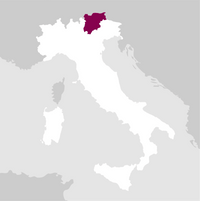Description
Pinot meunier means miller's pinot in Trentino dialect molinar. Pojer e Sandri was established in 1975 by setting up in an old mill in the Molini area. Sandri's ancestors on their mother's side were ‘the millers’.
Details

Perfume

Color

Taste
Serve at:
06 - 08 °C.
Longevity:
05 - 10 years

Pairings
- Start up year: 1975
- Oenologist: Mario Pojer
- Bottles produced: 250.000
- Hectares: 33
Faedo 1998: We are already starting to show our thirst for innovation: we are among the first at a national level to market Chardonnay, which until then was practically unknown.
Faedo 2002: We patent the reduction and press vinification with nitrogen recovery, which drastically reduces the use of sulphites. We then begin to wash the grapes through the grape jacuzzi.
The arrival of Marianna, Matteo, Fiamma, Elisa and Federico has brought further life and energy to this dream in which passion and innovation are the keystone.
Faedo 2013: The Zero Infinito project is born: Zero chemical treatments in the countryside, Zero sulphur dioxide, Zero commercial yeasts, Zero clarifying agents, Zero filtrations, Zero antioxidants. Read more


| Name | Pojer e Sandri Molinar Extra Brut 2020 |
|---|---|
| Type | Rosé green classic method sparkling wine extra brut |
| Denomination | VSQ |
| Vintage | 2020 |
| Size | 0,75 l |
| Alcohol content | 12.0% by volume |
| Grape varieties | 100% Pinot Meunier |
| Country | Italy |
| Region | Trentino Alto Adige |
| Vendor | Pojer e Sandri |
| Origin | San Michele A/A -Faedo in the locality of Molini |
| Climate | Altitude: 550 m above sea level with north-west exposure. |
| Soil composition | Sedimentary of marine origin from werfenian deposits of siltstone sandstone marlstone and dolomite. Varying in depth from 30 to 100 cm, it is sandy loamy and rests on a calcareous conglomerate. |
| Cultivation system | Double-arch Guyot. |
| Plants per hectare | 6200 |
| Yield per hectare | 70-80 q. |
| Harvest | From red varieties, vinified in pink. The grapes harvested in 100-kg crates are cooled in the refrigerator, the next day the bunches are washed and dried. Pressing, after brief maceration, takes place in a controlled atmosphere. Techniques developed in-house with the aim of safeguarding the fruit and colour and reducing the use of exogenous antioxidants. |
| Wine making | Fermentation takes place in small barrels placed on wheels, every week with the hourglass technique the barrel is turned 180° to have maximum yeast-wine contact. |
| Aging | In spring, re-fermentation takes place in the bottle and after 36 months on the yeast, disgorgement follows, which occurs without the addition of sugar. |
| Allergens | Contains sulphites |




